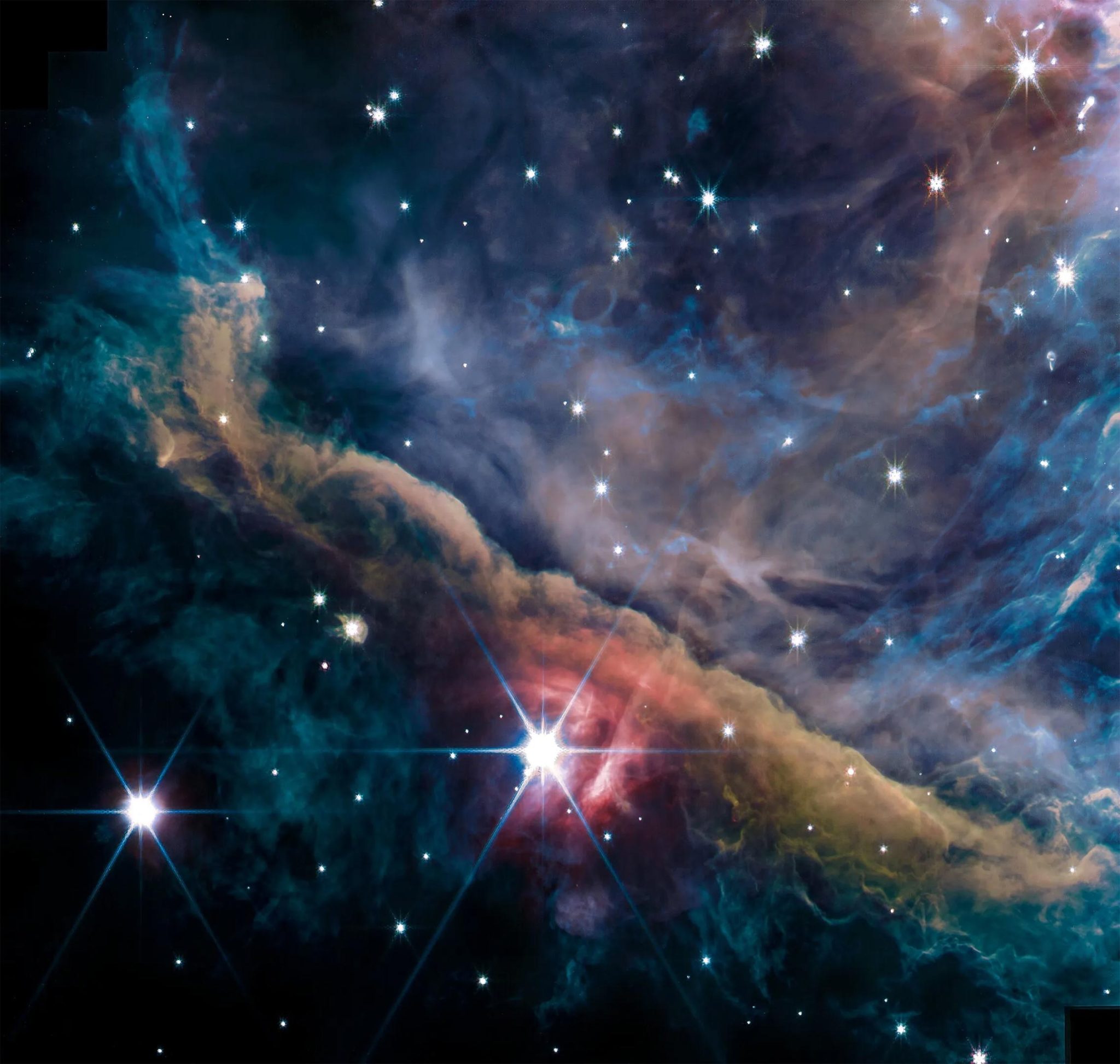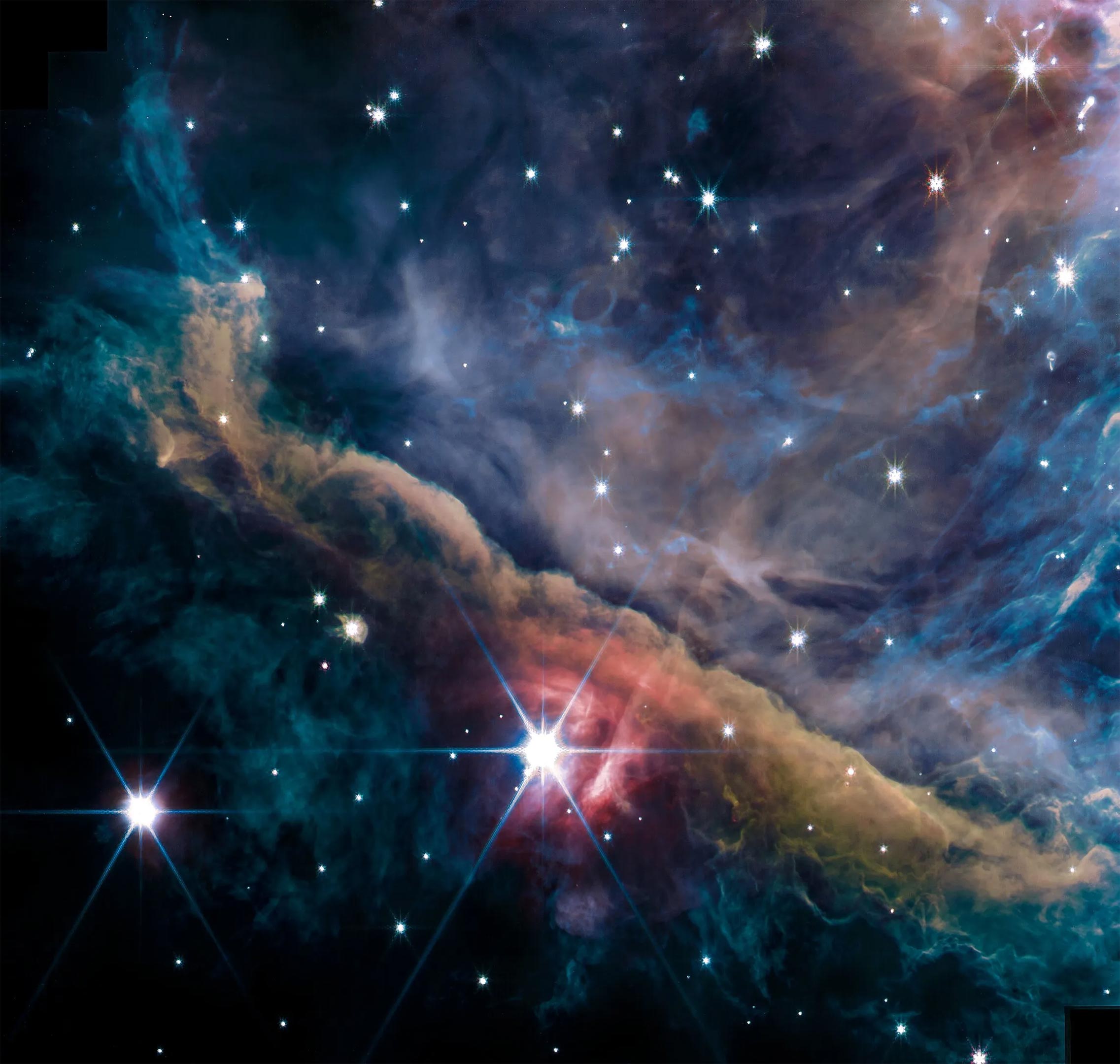
المنطقة الداخلية من سديم الجبار كما تراها أداة NIRCam التابعة لتلسكوب جيمس ويب الفضائي. إنها صورة مركبة للعديد من المرشحات التي تمثل الانبعاث من الغاز المتأين والغاز الجزيئي والهيدروكربونات والغبار وضوء النجوم المتناثر. حزام الجبار ، وهو جدار من الغاز والغبار الكثيف يمتد من أعلى إلى أسفل اليمين ، يحتوي على النجم اللامع θ.2 أوريونيس أ. يضيء المشهد مجموعة من النجوم الشابة الساخنة (تسمى مجموعة Trapezium Cluster) الموجودة في الجزء العلوي الأيمن من الصورة. تخلق الأشعة فوق البنفسجية القوية والمكثفة لـ Trapezium Cluster جوًا مؤينًا ساخنًا في الجزء العلوي الأيمن ، مما يؤدي إلى تآكل حزام Orion ببطء. يمكن للجزيئات والغبار البقاء على قيد الحياة لفترات طويلة في بيئة الحماية التي يوفرها الشريط الكثيف ، لكن اندفاع الطاقة النجمية يصنع منطقة. الائتمان: وكالة ناسا ووكالة الفضاء الأوروبية ووكالة الفضاء الكندية وتقليل البيانات وتحليلها: PDRs4All فريق ERS ؛ المعالجة الرسومية S. Fuenmayor
تكشف صور الويب الجديدة عن منظر رائع لسديم الجبار
Researchers at Western University in Ontario, Canada, were part of an international collaboration that targeted the newly released images.
“We are blown away by the breathtaking images of the Orion Nebula. We started this project in 2017, so we have been waiting more than five years to get these data,” said Western University astrophysicist Els Peeters.
These images have been obtained as part of the Early Release Science program Photodissociation Regions for All (PDRs4All ID 1288) on JWST. Co-led by Peeters, French National Centre for Scientific Research (CNRS) scientist Olivier Berné, and Institut d’Astrophysique Spatiale (IAS) associate professor Emilie Habart, PDRs4All is an international collaboration that involves a team of more than one hundred scientists in 18 countries. Other Western University astrophysicists involved in PDRs4All include Jan Cami, Ameek Sidhu, Ryan Chown, Bethany Schefter, Sofia Pasquini, and Baria Kahn.

Young star with disk inside its cocoon: Planet forming disks of gas and dust around a young star. These disks are being dissipated or “photo-evaporated” due to the strong radiation field of the nearby stars of the Trapezium creating a cocoon of dust and gas around them. Almost 180 of these externally illuminated photoevaporating disks around young stars (aka Proplyds) have been discovered in the Orion nebula, and HST-10 (the one in the picture) is one of the largest known. The orbit of Neptune is shown for comparison.
Filaments: The entire image is rich in filaments of different sizes and shapes. The inset here shows thin, meandering filaments that are especially rich in hydrocarbon molecules and molecular hydrogen.
θ2 Orionis A: The brightest star in this image is θ2 Orionis A, a star that is just bright enough to be seen with the naked eye from a dark location on Earth. Stellar light that is reflecting off dust grains causes the red glow in its immediate surroundings.
Young star inside globule: When dense clouds of gas and dust become gravitationally unstable, they collapse into stellar embryos that gradually grow more massive until they can start nuclear fusion in their core – they start to shine. This young star is still embedded in its natal cloud.
Credit: NASA, ESA, CSA, Data reduction and analysis: PDRs4All ERS Team; graphical processing S. Fuenmayor & O. Berné
“These new observations allow us to better understand how massive stars transform the gas and dust cloud in which they are born,” said Peeters. She is a Western University astronomy professor and faculty member at the Institute for Earth and Space Exploration.
“Massive young stars emit large quantities of ultraviolet radiation directly into the native cloud that still surrounds them, and this changes the physical shape of the cloud as well as its chemical makeup. How precisely this works, and how it affects further star and planet formation is not yet well known.”
The newly released images reveal numerous spectacular structures inside the nebula, down to scales comparable to the size of the Solar System.
“We clearly see several dense filaments. These filamentary structures may promote a new generation of stars in the deeper regions of the cloud of dust and gas. Stellar systems already in formation show up as well,” said Berné. “Inside its cocoon, young stars with a disk of dust and gas in which planets form are observed in the nebula. Small cavities dug by new stars being blown by the intense radiation and stellar winds of newborn stars are also clearly visible.”
Proplyds, or ionized protoplanetary disks, consist of a central protostar surrounded by a disk of dust and gas in which planets form. Scattered throughout the images are several protostellar jets, outflows, and nascent stars embedded in dust.
“We have never been able to see the intricate fine details of how interstellar matter is structured in these environments, and to figure out how planetary systems can form in the presence of this harsh radiation. These images reveal the heritage of the interstellar medium in planetary systems,” said Habart.

Orion Nebula: JWST versus Hubble Space Telescope (HST): The inner region of the Orion Nebula as seen by both the Hubble Space Telescope (left) and the James Webb Space Telescope (right). The HST image is dominated by emission from hot ionized gas, highlighting the side of the Orion Bar which is facing the Trapezium Cluster (off the top right of the image). The JWST image also shows the cooler molecular material that is slightly further away from the Trapezium Cluster (compare the location of the Orion Bar relative to the bright star θ2 Orionis A for example). Webb’s sensitive infrared vision can furthermore peer through thick dust layers and see fainter stars. This will allow scientists to study what is happening deep inside the nebula.
Credit: NASA, ESA, CSA, PDRs4All ERS Team; image processing Olivier Berné.
Credit for the HST image: NASA/STScI/Rice Univ./C.O’Dell et al. – Program ID: PRC95-45a. Technical details: The HST image used WFPC2 mosaic. This composite image uses [OIII] (أزرق) ، هيدروجين مؤين (أخضر) ، و [NII] (أحمر).
التطور التناظري
لطالما اعتبر سديم الجوزاء مهد النظام الشمسي (تشكل منذ حوالي 4.5 مليار سنة). هذا هو سبب اهتمام العلماء اليوم بمراقبة سديم الجبار. إنهم يأملون أن يفهموا عن طريق القياس ما حدث خلال المليون سنة الأولى من تطور كوكبنا.
إن قلوب المشاتل النجمية مثل سديم الجبار محجوبة بالكثير من الغبار النجمي لدرجة أنه من المستحيل دراسة ما يجري بداخلها بالضوء المرئي من خلال التلسكوبات. تلسكوب هابل الفضائي. يكتشف ويب ذلك ضوء الأشعة تحت الحمراء كوزموس ، الذي يسمح لعلماء الفلك برؤية طبقات الغبار هذه وكشف النشاط الذي يحدث في أعماق السديم.

الجزء الداخلي من سديم الجبار كما يراه تلسكوب سبيتزر الفضائي (يسار) وتلسكوب جيمس ويب الفضائي (يمين). تم تسجيل كلتا الصورتين باستخدام مرشح حساس بشكل خاص لانبعاث غبار الهيدروكربون ، والذي يضيء الصورة بأكملها. توضح هذه المقارنة كيف يتم مقارنة صور ويب شديدة الوضوح بشكل لا يصدق مع سابقتها التي تعمل بالأشعة تحت الحمراء ، تلسكوب سبيتزر الفضائي. يتضح هذا بسهولة من الخيوط المعقدة ، لكن عيون ويب الحادة تسمح له بتمييز النجوم بشكل أفضل عن الكريات وأقراص الكواكب الأولية.
الائتمان لصورة NIRCam: NASA و ESA و CSA و PDRs4All فريق ERS ؛ معالجة الصور بواسطة أوليفييه بيرنيه.
رصيد صورة Spitzer: NASA / JPL-Caltech / T. ماكجاث (جامعة توليدو ، أوهايو)
التفاصيل الفنية: تُظهر صورة Spitzer بواسطة كاميرا Spitzer’s Infrared Array Camera (IRAC) 3.6 ميكرون من ضوء الأشعة تحت الحمراء. تُظهر صورة JWST ضوء الأشعة تحت الحمراء بقدرة 3.35 ميكرون الملتقطة بواسطة كاميرا JWST NIRCam. البيكسلات السوداء عبارة عن قطع أثرية ناتجة عن تشبع أجهزة الكشف بالنجوم الساطعة.
“كانت مراقبة سديم الجبار تحديًا لأنه كان ساطعًا جدًا بالنسبة لأجهزة استشعار ويب غير المسبوقة. لكن ويب مذهل ، ويمكن لويب أن يرصد المجرات البعيدة والضعيفة.[{” attribute=””>Jupiter and Orion, which are some of the brightest sources in the infrared sky,” said Berné.
At the heart of the Orion Nebula is the ‘trapezium cluster’ (also known as Theta Orionis), which was discovered by Galileo. It contains young massive stars whose intense ultraviolet radiation shapes the cloud of dust and gas. Understanding how this intense radiation impacts their surroundings is a key question in understanding the formation of stellar systems like our own solar system.
“Seeing these first images of the Orion Nebula is just the beginning. The PDRs4All team is working hard to analyze the Orion data and we expect new discoveries about these early phases of the formation of stellar systems,” said Habart. “We are excited to be part of Webb’s journey of discoveries.”
Webb is the most powerful space telescope ever created in human history. It was developed in partnership with NASA, the European Space Agency, and the Canadian Space Agency (CSA), and boasts an iconic 6.5-meter-wide mirror, consisting of a honeycomb-like pattern of 18 hexagonal, gold-coated mirror segments and a five-layer, diamond-shaped sunshield the size of a tennis court. As a partner, CSA receives a guaranteed share of Webb’s observation time, making Canadian scientists some of the first to study data collected by the most advanced space telescope ever constructed.

“متعصب للموسيقى. مستكشف متواضع جدا. محلل. متعصب للسفر. مدرس تلفزيوني متطرف. لاعب.”

